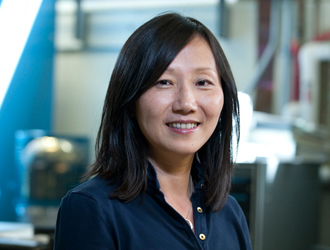Stanford professor Zhenan Bao has demonstrated the feasibility of using off-the-shelf carbon materials to build flexible, printable, lightweight and inexpensive solar cells.
The three main components of Bao’s innovative all-carbon solar cell comprise a carbon nanotube cathode, a graphene anode and, sandwiched inside the anode, an active layer made of nanotubes and buckyballs. What makes the potential to cut costs so promising is that all components were made by either printing or evaporating from inks.
The biggest obstacle to making the all-carbon solar, as well as the main limiting factor in its efficiency, is making the cathode. Carbon nanomaterials tend not to collect electrons. Bao and her Stanford team solved the problem by picking the right type of nanotubes and treating them chemically.
Bao’s all-carbon cells only convert 1% of sunlight into electricity, compared with around 20% for the most efficient types of silicon solar cells. She says the inefficiency is caused by the roughness of the carbon films which impedes the flow of electrons to the cathode. She thinks that can be overcome by modifying the processing method.
Theoretically an all-carbon solar cell should be able to achieve 13% efficiency by fine-tuning the as materials and processes, according to calculations by MIT researcher Jeffrey Grossman.
A 5% efficiency level has already been attained by IBM Yorktown researcher Shenqiang Ren, an assistant professor of chemistry at the University of Kansas. However, Ren’s carbon solar cells aren’t all-electric, being equipped with conventional metal electrodes. He thinks a 10% efficiency is in sight, and that’s the level at which carbon-based solar cells would be commercially feasible due to their potential to achieve excellent cost efficiencies as well as their attractiveness for applications where both light weight and flexibility would be crucial.
Ultimately, all-carbon solar cells and other electronic components could even be sprayed directly onto the sides of buildings or be manufactured in large, ultra-thin sheets that can be rolled up and transported easily to places where electricity is needed. As Bao points out, the use of carbon nanomaterials is in its infancy. Her all-carbon solar cell was intended to be a proof-of-concept rather than a commercially viable product.
Bao has also used principles similar to those used in her all-carbon solar cells to unveil in September 2010 a polymer sheet sensitive enough to pressure to be used as covering for prosthetic limbs with a human-like sense of touch.
Bao is currently a professor of chemical engineering at Stanford University. She graduated from Nanjing University in China before earning a PhD in chemistry from The University of Chicago in 1995.
She began her professional career at Bell Labs’ materials research department where she was honored as a Distinguished Member of Technical Staff in 2001. She joined the Stanford chemical engineering faculty in 2004.
Bao is credited with over 280 refereed publications and over 50 US patents. She has served as a member of Executive Board of Directors for the Materials Research Society and Executive Committee Member for the Polymer Materials Science and Engineering division of the American Chemical Society. She is an Associate Editor of Synthetic Metals. Her research work has been recognized by numerous international awards.


